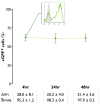Short-term cultured, interleukin-15 differentiated dendritic cells have potent immunostimulatory properties
- PMID: 20021667
- PMCID: PMC2807857
- DOI: 10.1186/1479-5876-7-109
Short-term cultured, interleukin-15 differentiated dendritic cells have potent immunostimulatory properties
Abstract
Background: Optimization of the current dendritic cell (DC) culture protocol in order to promote the therapeutic efficacy of DC-based immunotherapy is warranted. Alternative differentiation of monocyte-derived DCs using granulocyte macrophage colony-stimulating factor (GM-CSF) and interleukin (IL)-15 has been propagated as an attractive strategy in that regard. The applicability of these so-called IL-15 DCs has not yet been firmly established. We therefore developed a novel pre-clinical approach for the generation of IL-15 DCs with potent immunostimulatory properties.
Methods: Human CD14+ monocytes were differentiated with GM-CSF and IL-15 into immature DCs. Monocyte-derived DCs, conventionally differentiated in the presence of GM-CSF and IL-4, served as control. Subsequent maturation of IL-15 DCs was induced using two clinical grade maturation protocols: (i) a classic combination of pro-inflammatory cytokines (tumor necrosis factor-alpha, IL-1beta, IL-6, prostaglandin E2) and (ii) a Toll-like receptor (TLR)7/8 agonist-based cocktail (R-848, interferon-gamma, TNF-alpha and prostaglandin E2). In addition, both short-term (2-3 days) and long-term (6-7 days) DC culture protocols were compared. The different DC populations were characterized with respect to their phenotypic profile, migratory properties, cytokine production and T cell stimulation capacity.
Results: The use of a TLR7/8 agonist-based cocktail resulted in a more optimal maturation of IL-15 DCs, as reflected by the higher phenotypic expression of CD83 and costimulatory molecules (CD70, CD80, CD86). The functional superiority of TLR7/8-activated IL-15 DCs over conventionally matured IL-15 DCs was evidenced by their (i) higher migratory potential, (ii) advantageous cytokine secretion profile (interferon-gamma, IL-12p70) and (iii) superior capacity to stimulate autologous, antigen-specific T cell responses after passive peptide pulsing. Aside from a less pronounced production of bioactive IL-12p70, short-term versus long-term culture of TLR7/8-activated IL-15 DCs resulted in a migratory profile and T cell stimulation capacity that was in favour of short-term DC culture. In addition, we demonstrate that mRNA electroporation serves as an efficient antigen loading strategy of IL-15 DCs.
Conclusions: Here we show that short-term cultured and TLR7/8-activated IL-15 DCs fulfill all pre-clinical prerequisites of immunostimulatory DCs. The results of the present study might pave the way for the implementation of IL-15 DCs in immunotherapy protocols.
Figures








Similar articles
-
Interferon-alpha and viral triggers promote functional maturation of human monocyte-derived dendritic cells.Br J Dermatol. 2008 May;158(5):921-9. doi: 10.1111/j.1365-2133.2008.08508.x. Epub 2008 Mar 25. Br J Dermatol. 2008. PMID: 18371115 Free PMC article.
-
Unexpected impairment of TNF-α-induced maturation of human dendritic cells in vitro by IL-4.J Transl Med. 2016 Apr 14;14:93. doi: 10.1186/s12967-016-0848-2. J Transl Med. 2016. PMID: 27080531 Free PMC article.
-
IFN-alpha skews monocyte differentiation into Toll-like receptor 7-expressing dendritic cells with potent functional activities.J Immunol. 2003 Oct 1;171(7):3385-93. doi: 10.4049/jimmunol.171.7.3385. J Immunol. 2003. PMID: 14500632
-
Dendritic cell biology and the application of dendritic cells to immunotherapy of multiple myeloma.Med Oncol. 2000 Feb;17(1):2-15. doi: 10.1007/BF02826210. Med Oncol. 2000. PMID: 10713654 Review.
-
Toll-like receptor expression and function in human dendritic cell subsets: implications for dendritic cell-based anti-cancer immunotherapy.Cancer Immunol Immunother. 2010 Oct;59(10):1573-82. doi: 10.1007/s00262-010-0833-1. Epub 2010 Mar 5. Cancer Immunol Immunother. 2010. PMID: 20204387 Free PMC article. Review.
Cited by
-
Optimizing dendritic cell-based immunotherapy: tackling the complexity of different arms of the immune system.Mediators Inflamm. 2012;2012:690643. doi: 10.1155/2012/690643. Epub 2012 Jul 18. Mediators Inflamm. 2012. PMID: 22851815 Free PMC article. Review.
-
STAT3 signaling contributes to the high effector activities of interleukin-15-derived dendritic cells.Immunol Cell Biol. 2015 May-Jun;93(5):461-71. doi: 10.1038/icb.2014.103. Epub 2015 Jan 13. Immunol Cell Biol. 2015. PMID: 25582338 Free PMC article.
-
Research progress on dendritic cell vaccines in cancer immunotherapy.Exp Hematol Oncol. 2022 Jan 24;11(1):3. doi: 10.1186/s40164-022-00257-2. Exp Hematol Oncol. 2022. PMID: 35074008 Free PMC article. Review.
-
IL-15 Generates IFN-γ-producing Cells Reciprocally Expressing Lymphoid-Myeloid Markers during Dendritic Cell Differentiation.Int J Biol Sci. 2019 Jan 1;15(2):464-480. doi: 10.7150/ijbs.25743. eCollection 2019. Int J Biol Sci. 2019. PMID: 30745835 Free PMC article.
-
HPV vaccine stimulates cytotoxic activity of killer dendritic cells and natural killer cells against HPV-positive tumour cells.J Cell Mol Med. 2014 Jul;18(7):1372-80. doi: 10.1111/jcmm.12284. Epub 2014 Jun 30. J Cell Mol Med. 2014. PMID: 24979331 Free PMC article.
References
Publication types
MeSH terms
Substances
LinkOut - more resources
Full Text Sources
Other Literature Sources
Molecular Biology Databases
Research Materials

